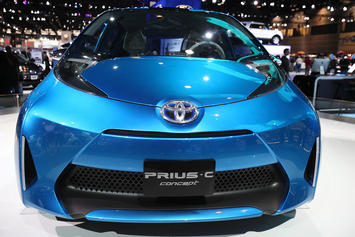
The Environmental Protection Agency (EPA) has just finalized its regulation requiring that new cars and light trucks (light vehicles) achieve average fuel efficiency of 54.5 miles per gallon (MPG) by 2025 (4.3 liters per 100 kilometers). This increase in the "CAFE" standard (Corporate Average Fuel Efficiency) is the second major step in the Obama Administration's program to improve light vehicle fuel efficiency. In 2010, EPA adopted regulations requiring 35.5 MPG average by 2016 (6.6 liters per 100 kilometers).
The EPA standard is based upon carbon dioxide (CO2) grams emitted per mile of light vehicle travel, with an average of 163 grams per mile (101 per kilometer) to be achieved in 2025. This is slightly above the 2020 European Union standard of 152 grams per mile (95 grams per kilometer). Of course, the regulations have both supporters and detractors, with the automobile manufacturers being among the supporters.
Assuming the objectives are met, the reductions in CO2 emissions will dwarf the modest gains forecast from anti-suburban smart growth policies. For decades, this powerful movement has sought to limit or prohibit suburban expansion and even outlaw the detached housing that most people prefer. This includes railing against automobile use and seeking to coerce people out of their cars (as expressed by Secretary of Transportation Ray LaHood).
The anti-suburban movement has many labels in addition to "smart growth," such as “densification policy," "compact cities," "growth management," "urban consolidation," etc. The origins can be traced back to just after World War II, with the enactment of the British Town and Country Planning Act. The policy origins of smart growth in the United States date from the 1960s (the state of Hawaii) and 1970s (the state of Oregon and California local jurisdictions).
Forecast CO2 Emission Reductions from Smart Growth
With concerns about greenhouse gas (GHG) emissions (principally carbon dioxide, or CO2), proponents saw the opportunity to force people back into the cities (from which most did not come) and turn smart growth into an imperative for "saving the planet." This is no exaggeration. As late as last month, this was claimed by fellow panelists at a Maryland Association of Counties conference. As is indicated below, the data shows no such association.
Even forecasts by proponents fall short of demonstrating an apocalyptic necessity for smart growth. The Cambridge Systematics and Urban Land Institute Moving Cooler report attributed only modest reductions in CO2 emissions to smart growth's land use and mass transit policies (Moving Cooler was criticized on this site by Alan Pisarski. See ULI Moving Cooler Report: Greenhouse Gases, Exaggerations and Misdirections). The data in Moving Cooler suggests an approximately 50 million ton reduction in CO2 emissions from these smart growth strategies by 2035 (interpolating between 2030 and 2050 figures).
The more balanced Transportation Research Board Driving and the Built Environment: The Effects of Compact Development on Motorized Travel, Energy Use, and CO2 Emissions produced similar figures, however it indicated skepticism about whether their higher range projections were "plausible."
Comparing Smart Growth to the Previous Fuel Economy Standard
At the 2005 fuel economy rate and the projected driving increase rate in the US Department of Energy Annual Energy Outlook:2008 (AEO), CO2 emissions from light vehicles would have increased 64 percent from 2005 to 2035 (Note 1). This could be called the "baseline" case or the "business as usual" case. This would have resulted in a CO2 emissions increase from light vehicles of approximately 0.75 billion tons.
Using the more aggressive Moving Cooler forecast, the smart growth transport and land use strategies would only minimally reduce CO2 emissions from the baseline case (64 percent above 2005 levels) to 60 percent. This is "chicken feed" (Figure 1).
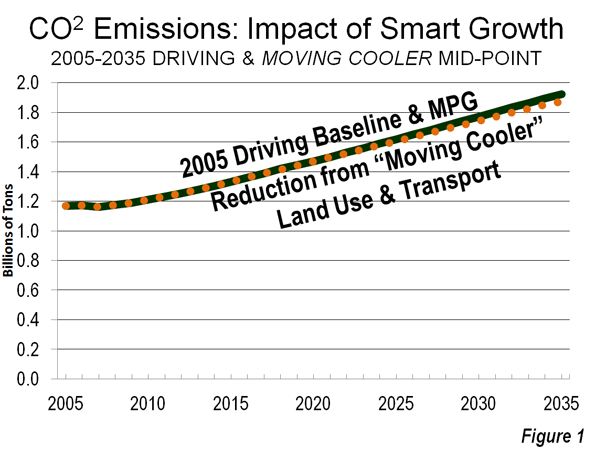
Forecast CO2 Emission Reductions from the 54.5 MPG Standard
Under the previous 35.5 MPG standard, AEO:2008 and AEO:2012, a 19 percent reduction in CO2 emissions from cars and light trucks would occur from 2005 to 2035. We modeled the new regulations based upon AEO:2012 forecasts for the earlier regulation. This yielded a 2035 CO2 emission reduction of 35 percent from 2005 (Figure 2), despite a healthy one-third increase in driving volumes over the period. The calculation also includes an upward adjustment for the rebound effect, as lower costs of driving encourage people to drive more, which EPA estimates at 10 percent ("induced traffic"), which is indicated in Figure 3.
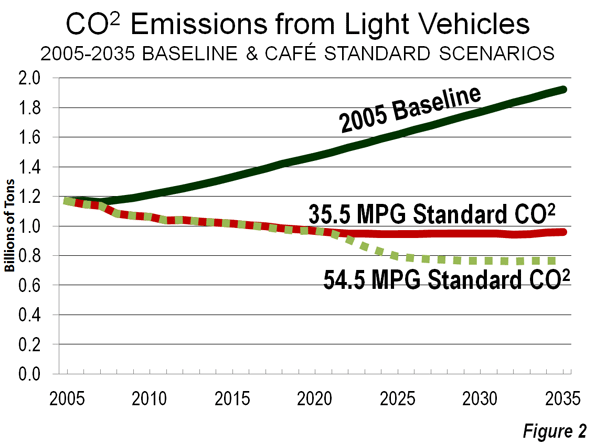
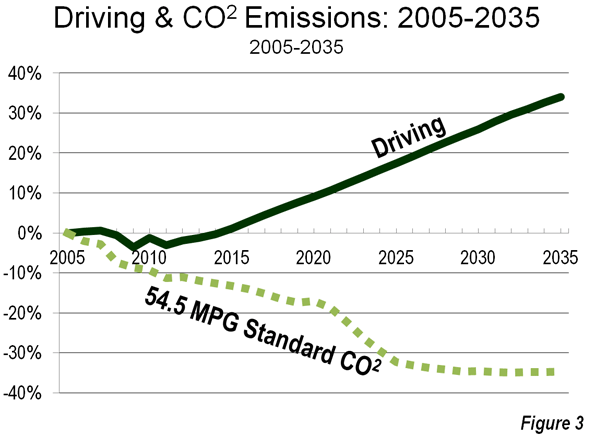
Achievement of the 54.5 MPG standard would reduce CO2 emissions from light vehicles from 1.9 billion annual tons in 2035 under the 2005 baseline to approximately 0.750 billion metric tons in 2035. Approximately 70 percent of the decline in CO2 emissions would be from improved fuel economy, while 30 percent would be from slower annual increase in vehicle travel that has been adopted in AEO:2012 (Figure 4). The increase in driving is now forecast at 33 percent from 2005.
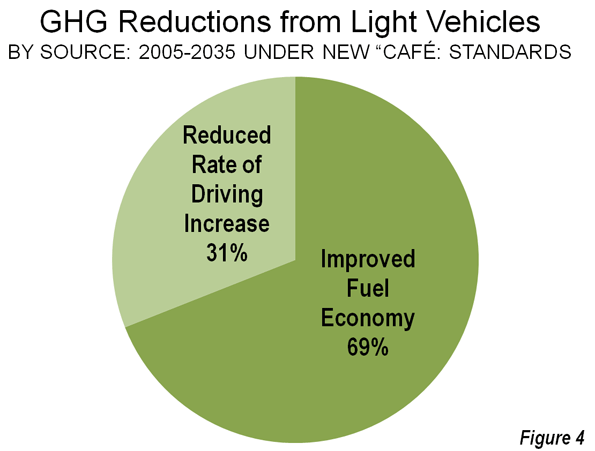
The contrast between the potential CO2 emissions from smart growth and fuel economy is stark. By comparison, the annual overall reduction in CO2 emissions (from the 2005 baseline) would be virtually equal to the 30 year impact of smart growth (Figure 5).
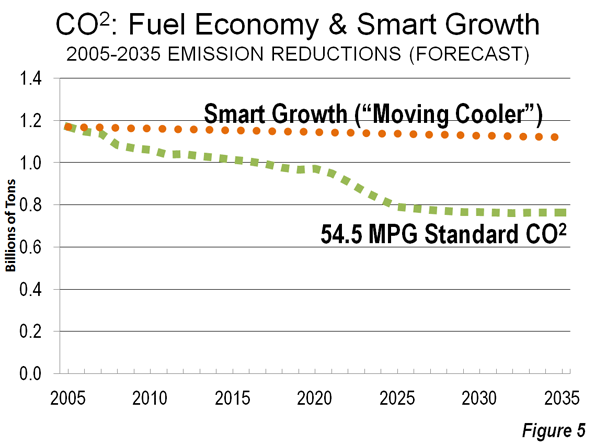
Comparison with Transit
The 35.5 MPG standard would make cars and light trucks less CO2 intensive than transit. At work trip vehicle occupancy rates, the average new light vehicle would emit less in CO2 per passenger mile in 2016 than transit in all but eight of the nation's 51 metropolitan areas over 1,000,000 population. The 2025 54.5 MPG standard would drop that number to two (Note 2). Even before these developments, there was only scant potential for replacing automobile use with transit (much less walking or cycling) because of its long travel times. According to data in a Brookings Institution report, less than 10 percent of jobs in the largest metropolitan areas can be reached by the average resident in 45 minutes on transit (Note 3).
Smart Growth: Not Needed to "Save the Planet"
Smart growth is an exceedingly intrusive policy that would attempt to enforce personal behaviors, counter to people's preferences, by attempting to dictate where people live and how they travel. This is expensive as well as intrusive. It is also detrimental to the economy, which is already taking a toll in lower household discretionary income (especially from higher house prices) and stunted economic growth.
A report by The McKinsey Corporation and The Conference Board indicated that sufficient CO2 emissions could be achieved with "…no downsizing of vehicles, home or commercial space and traveling the same mileage" and "…no shift to denser housing." Or, more directly, smart growth is unnecessary, in addition to producing little "gain" for the "pain."
Wendell Cox is a Visiting Professor, Conservatoire National des Arts et Metiers, Paris and the author of “War on the Dream: How Anti-Sprawl Policy Threatens the Quality of Life.”
----
Note 1: The 2030 to 2035 driving volume is estimated using the annual percentage increase from 2025 to 2030 in AEO: 2008, which has data through 2030.
Note 2: Calculated from 2010 National Transit Database summary by Randal O'Toole of the Cato Institute. These calculations assume the 250 gram per mile standard for new light vehicles in 2016 and the vehicle occupancy ratio of 1.13 for work trips from the 2009 National Household Travel Survey.
Note 3: Limited transit access is not just an American problem. In Paris, with arguably the best transit system in the western world, the average resident of a suburban new town on the regional metro (RER) can reach twice as many jobs by car as by transit in an hour, according to Fouchier and Michelon.
Prius photo by Bigstock.













Obama Fuel Economy
President Obama will order the Environmental Protection Agency and the Department of Transportation to create and issue new fuel efficiency and greenhouse gas standards. The law of supply and demand would predict that an increase in gasoline prices would lead in the long run to an increase in the average fuel economy. Obama said helping these vehicles use less fuel would have the triple benefit of making the U.S. less dependent on imported oil, keeping more money in consumer pockets and reducing the greenhouse gas emissions blamed for global warming.Obama discussed the need for new fuel-efficiency standards in last month's State of the Union address, as well as in the climate change . BMW Service Chicago
CONFUSED BY COLUMN - AND CLARIFICATION NEEDED
Wendell,
As a self-described smart growth advocate, I can tell you that the new CAFE standards, IMO, work AGAINST smart growth principles in the sense that "driving further on a gallon of gas", as the Sierra Club put it in their battle for improved CAFE, only serves to promote sprawl - is that what you attempt to state in your essay?
I think it shows that the "efficiency" crowd is not the same as the smart growth community, though I think our end goals are similar, e.g. fighting climate change.
As for the correction - you state that the CAFE standards are from EPA - no so. They are from NHTSA. EPA dealt with the GHG emissions, not the fuel economy. The new standards combined the recommendations from three agencies: EPA, NHTSA, and CARB (California), and that was an improvement in itself.
Irvin Dawid
Pollution is obtaining worse day by day
Pollution is obtaining worse day by day, it's solely due to smoke of vehicles. it's a headache for all scientists. Environmental protection agency has taken an honest decide to integrate a lot of zero-emission vehicles into the market. very it's a good step towards reduction of pollution. click here http://www.sunnybunny.org/
The economic illiteracy at the heart of Smart Growth
The idiocy of the "Smart Growth" crowd is even worse than what you say. All their glorious projected efficiency gains from "intensification", utterly ignore what real estate markets do in response to heightened demand for specific locations, whether that demand is natural or coerced.
It is the height of economic ignorance to assume that a significant proportion of the population in any city, can shift in towards the centre of that city, and the prices of the properties they are buying will conveniently remain affordable to everyone thus shifting, the late-comers as well as the early birds. DOH! DOH! DOH!
Of course when the population is moving out towards and onto the rural land beyond the fringe, prices remain affordable, because the "supply" in that direction is de facto infinite. But is the "supply" de facto infinite at the centre of the city? DOH! DOH! DOH!
Even the old lefty Anthony Downs "gets it": at least as far back as his presentation “A Growth Strategy for the Greater Vancouver Region”, 2007:
"......The cost of land poses a key dilemma for urban planners everywhere who want to concentrate jobs together so they can be best served by public transit. Such concentration raises the costs of land near centers; in fact, it would confer a monopoly advantage on landowners who owned such land and could exploit firms trying to locate there. Now firms want to locate elsewhere to cut their land costs.
Planned concentration of jobs in a few centers is not consistent with private ownership and control of land. Some type of collective control over that land would be necessary to prevent monopolistic exploitation of land values. In theory, this could be done with high land taxes in such areas and special zoning rules. But adopting those devices is politically difficult in a free enterprise economy.......
"......A similar but less intensive dilemma concerns land near transit stops, where it would be most efficient to concentrate high-density housing and jobs. That also creates ownership monopolies over such land unless it is specially controlled or taxed. Yet focusing development near transit stops is a key to using more transit....."
http://anthonydowns.com/2007/03/a-growth-strategy-for-the-greater-vancou...